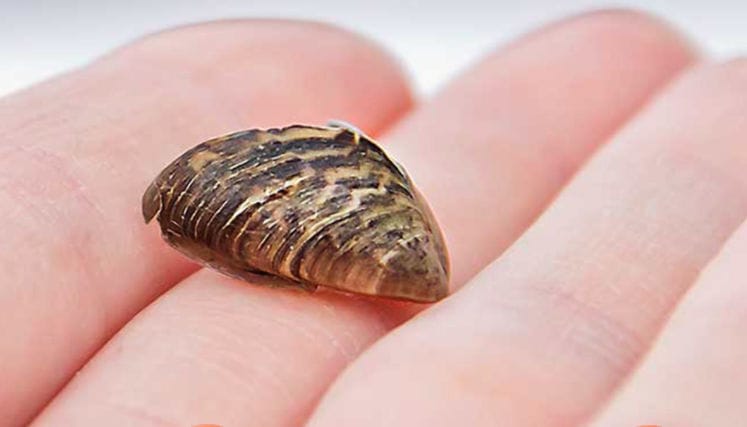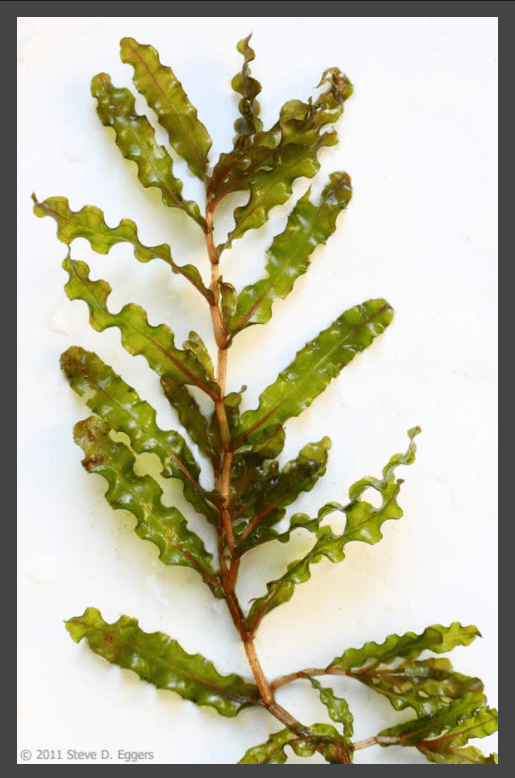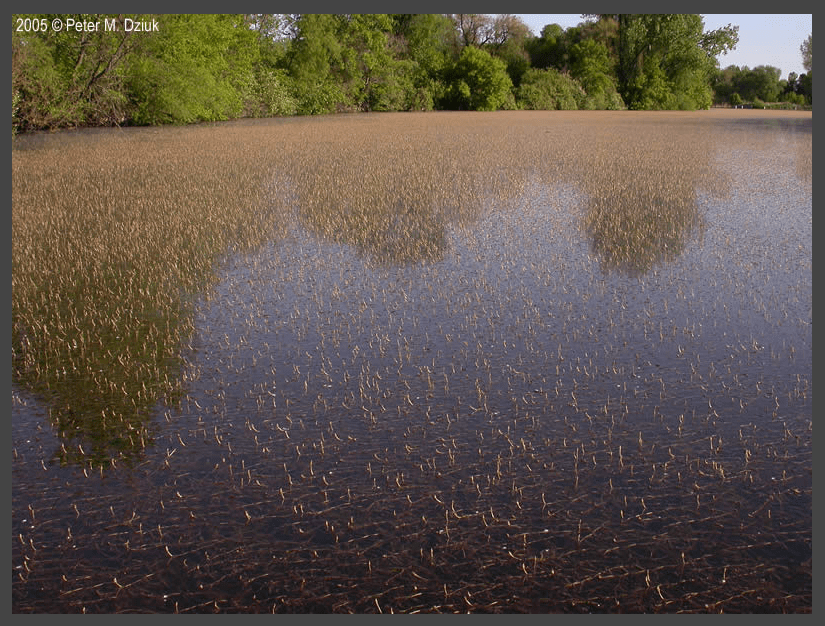Aquatic Invasive Species
 As part of our mission, the Pickerel Lake Conservancy monitors Pickerel Lake for invasive species. Working with the SD Game, Fish & Parks, NE Glacial Lakes Watershed Project, other agencies, and consultants, we will provide current information on the status of AIS in our waters. We highlight two invaders here and provide resources to help inform visitors coming to Pickerel Lake.
As part of our mission, the Pickerel Lake Conservancy monitors Pickerel Lake for invasive species. Working with the SD Game, Fish & Parks, NE Glacial Lakes Watershed Project, other agencies, and consultants, we will provide current information on the status of AIS in our waters. We highlight two invaders here and provide resources to help inform visitors coming to Pickerel Lake.
Zebra Mussels in Pickerel Lake
Pierre, S.D. – The South Dakota Department of Game, Fish and Parks (GFP) has confirmed the presence of adult zebra mussels in Pickerel Lake in Day County.
“A suspected adult zebra mussel was found at the west boat ramp in Pickerel State Park early this morning by Dennis Skadsen, the project manager for the Northeast Glacial Lakes Watershed Improvement and Protection Project, while working on a project for Game, Fish and Parks,” said GFP region fisheries supervisor, Mark Ermer. “After confirming it to be a zebra mussel, Dennis Skadsen, conducted additional sampling and mussels were sampled near the East Pickerel Lake State Park boat ramp and the old fish hatchery site. We currently do not know the level of infestation, but crews will be sampling the lake next week.” Pickerel Lake is now considered “infested” for zebra mussels.
 This is the first documented zebra mussel in the northeast, glacial lakes region. Pickerel Lake is now classified as infested with zebra mussels.
This is the first documented zebra mussel in the northeast, glacial lakes region. Pickerel Lake is now classified as infested with zebra mussels.
The (GFP) Commission can designate waters infested with zebra mussels as containment waters. Specific decontamination requirements exist for boats kept in these waters continuously for three or more days, or that cannot have all water drained from them.
“Cabin owners with watercraft on docks and slips and other boaters that fall into these categories need to learn how to properly decontaminate their boats to slow the spread of zebra mussels,” said Ermer.
This discovery makes it even more important for boaters to follow the Aquatic Invasive Species rules. Every time they leave the water, all boaters and anglers should:
- Clean watercraft and trailers of all aquatic plants and mud
- Drain all water by removing all drains, plugs, bailers, or valves that retain water. Be sure to completely drain your lower unit of any water by lowering completely.
- Dispose of unwanted bait in trash or fish cleaning stations when leaving the water
Completely draining a boat is the first step in making sure invasive species are not transferred to other waters.
For more information on zebra mussels, other aquatic invasive species, and how to properly decontaminate your watercraft, visit BOAT WASHING TIPS AND LOCATIONS and KEEP ZEBRA MUSSELS OFF YOUR WATERCRAFT and DOES MY WATERCRAFT NEED A DECONTAMINATION?
Please view the 2022 update by Meg Duhr from the annual meeting.

Courtesy of Mn Wildflowers, photo by Peter Dziuk
Curly-leaf Pondweed Plan for Pickerel Lake
In late summer 2019, fragments of curly-leaf pondweed (CLWP) were first identified in the northwest portion of Pickerel Lake. The PLC sounded the alarm on this issue and is leading the fight to combat CLPW. We are providing information about CLPW, why it is a problem, and the PLC’s plans to combat CLPW at Pickerel.
Why CLPW is a problem.
CLPW is an invasive aquatic plant that has been found in many lakes in the United States. Like many invasive species, CLPW is spread from one body of water to another by an unintentional transfer of plant fragments on boat trailers. CLPW is an aggressive, fast growing aquatic plant with unique characteristics which make it difficult to combat and eradicate. Unlike native aquatic vegetation which remains dormant over the winter, CLPW starts to grow during the winter months when the lake is covered with ice and snow, even with little sunlight. CLPW grows very rapidly in early spring as soon as the ice is out. It is therefore way ahead of native aquatic plants in terms of spring growth and propagation.

Courtesy of Mn Wildflowers, photo by Steve Eggers
CLPW usually reaches its maximum height and growth stage in late May and early June. At that point, it reaches the lake surface. Generally, CLPW grows in water 15 feet deep or less. The plants produce what are called “turions,” analogous to pine cones, which are produced when the plant reaches maximum height in late spring/early summer. CLPW propagates by dropping the turions on to the lake bottom, which then sprout next fall or winter.
CLPW forms heavy, dense weed mats that can be 3 to 10 feet deep. These dense mats of vegetation can make boat traffic difficult to impossible, prevent swimming and hinder other lake activities. Due to the dense nature of CLPW, it displaces native aquatic plants. By midsummer, CLPW plants usually die. As the large mass of dead plant material decomposes, it depletes oxygen and adds phosphorus to the water. The extra phosphorus generated by the decomposition process adds to the existing phosphorus problems in freshwater lakes. This creates an additional problem by worsening late summer algae blooms. In addition, the dead plant material eventually washes onto lakeshore beaches where it is a nuisance and must be removed.
PLC’s plan to combat CLPW
PLC has retained PLM Lake & Land Management Corp. to develop and implement a plan to combat CLPW at Pickerel. PLM has over 15 years of experience working with lake associations, state agencies, municipalities, watershed districts, and others in combating and managing various aquatic invasive species, including CLPW. PLM is very well qualified and is highly recommended. SD GF&P reviewed the PLM proposal and supports our plan to use PLM to combat CLPW. (But GF&P has no money to help in this effort.)
In Spring 2020, PLM will conduct what it refers to as a “delineation survey” of Pickerel. This survey involves traversing the entire shoreline of the lake by boat in depths 15 feet and less to visually identify CLPW. CLPW is easy to identify in late spring because it is the only aquatic vegetation visible at the surface of the lake. In locations where CLPW is identified, PLM will conduct a more detailed survey to determine the scope of the infestation.
Based on the survey, PLM will prepare a written plan with recommendations on how to combat and control CLPW in Pickerel now and in the future. At this point, we do not know the extent of the infestation. Typically, CLPW is controlled by the application of an herbicide. There are several different herbicides that can be used. Some of these have an adverse effect on native vegetation. Therefore, in late summer 2020 PLM will conduct a follow up survey of vegetation in the lake to catalog the types of native vegetation present. This will enable PLM to select the appropriate herbicide to combat CLPW while having the least impact on native plant species in the lake.

Courtesy of Mn Wildflowers, photo by Peter M. Dziuk
Depending on the scope of the infestation, we can expect that PLM will recommend the application of an herbicide in the spring of 2021. PLM will probably recommend an additional survey of the lake in the spring of 2021 to once again identify the location of CLPW infestations. PLM uses a sophisticated technology to properly apply the herbicide and to incorporate variables such as water depth, water flow, wave action, etc. The herbicides are quite effective, but must be properly and carefully applied in order to have optimum impact. If we are lucky, the infestation will be small, and we may be able to eradicate CLPW. PLM has had significant successes in controlling CLPW. However, once established CLPW is notoriously difficult to eliminate and if there is an infestation, the effort to control CLPW could take years. We expect to have an ongoing relationship with PLM as we continue our efforts to combat CLPW in the years ahead. We will keep you informed about the battle to combat CLPW.
What you can do.
We need your help in this process. First,we need your help identifying CLPW plants in the lake. CLP grows in water 15 feet deep or less. It may be growing adjacent to your dock or boat lift. Please refer to the CLPW photographs. If you see a plant that looks like CLPW, please take a picture, collect a sample, and report your findings to the PLC at ais@pickerellakeconservancy.org so we can determine whether or not it is CLPW. Identification can sometimes be tricky because CLPW closely resembles a native plant. If you do identify what you think is CLPW, mark the location carefully so we can do further investigation of that area. Combating CLPW is a long-term and expensive battle. Please contribute to the PLC. The PLC is working to protect the lake, your enjoyment of the lake and your property values. So please become a member and help us fight CLPW and other aquatic invasive species.
Thank you. Pickerel Lake Conservancy
How You Can Help
One of the most important things you can do is
Laws and Regulations
The discovery of zebra mussels in Lake Sharpe and Lake Francis Case in the summer of 2019 was “a game-changer” for the fight against invasive species across South Dakota. Throughout this fight, aquatic invasive species (AIS) regulations have been created and adopted to prevent the spread of this species. Find out what you can do to make sure you are following all the regulations and doing your part to combat invasive species in South Dakota.
General Regulations
- You may not possess, transport, sell, purchase, or propagate an aquatic invasive species. For invasive fish and crayfish, only dead specimens may be transported or possessed.
- Exceptions include:
- An employee of a business approved by the department may transport and possess watercraft with AIS for the purpose of watercraft decontamination.
- An owner or agent of the owner of a boat registered in a department-approved local boat registry may transport and possess an aquatic invasive species in accordance with the provisions of the registry.
- Exceptions include:
- You must pull your plugs immediately after loading your boat and leave the plugs out until you are putting the boat back on the water.
- Never transport lake or river water away from the access area, including in bait buckets, livewells, coolers or other containers.
- Dispose of unwanted bait in a dumpster, fish grinder, or other appropriate disposal location.
- Immediately after loading your boat, inspect both your boat and trailer for any mud, plants, animals or other debris and remove anything you find.
CLEAN. DRAIN.DRY EVERY TIME!
What species are classified as “aquatic invasive species” in South Dakota?
Fish
- Black carp, bighead carp, blotched snakehead, bullseye snakehead, common carp, European rudd, giant snakehead, grass carp, northern snakehead, round goby, silver carp, western mosquitofish and white perch.
Plants
- Brittle naiad, common reed, curly pondweed, didymo, Eurasian water-milfoil, flowering rush, purple loosestrife, and starry stonewort.
Invertebrates
- Asian clam, New Zealand mudsnail, quagga mussel, red rimmed melania, red swamp crayfish, rusty crayfish, spiny waterflea and zebra mussel.
What lakes are designated as “containment waters” and have zebra mussels present?
- Lake Sharpe
- Lake Francis Case
- Lewis and Clark Lake and the Missouri River upstream of the lake to Fort Randall Dam;
- The Missouri River from Gavins Point Dam downstream to the confluence with the Big Sioux River;
- McCook Lake in Union County;
- Lake Yankton in Yankton County; and
- Waters outside of South Dakota that are designated by a legal jurisdiction as infested by zebra or quagga mussels.
What is the “Drain Plug Rule”?
Except for emergency response boats, all trailered boats shall have all drain plugs, bailers, valves or other devices used to control the drainage of water opened or removed, except while in a boat ramp parking area or while being launched or loaded.
UNLESS YOU’RE LOADING, LAUNCHING OR ON THE WATER, All PLUGS MUST BE OUT
When am I required to decontaminate?
- Whenever AIS are present on your watercraft
- After using a containment water and:
a) Not all water can be drained.
A watercraft that has been loaded on a trailer or otherwise removed from a containment water that retains one gallon or more of water after all drain plugs, bailers, valves, or other devices used to control the drainage of water have been opened or removed, must be decontaminated by a department-approved decontamination procedure prior to the next launch, unless the watercraft is registered in the Lewis and Clark local boat registry and the boat owner or operator abides by the provisions of the registry.
OR
b) Your boat has been moored for 3 or more days.
Watercraft that are moored, or have any part continuously in the water, for three or more consecutive days on a containment water must be decontaminated by a department-approved decontamination procedure prior to the next launch of the watercraft.
